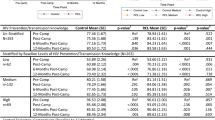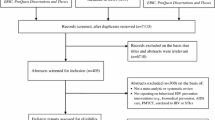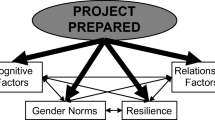Abstract
To address global questions regarding the timing of HIV-prevention efforts targeting youth and the possible additional benefits of parental participation, researchers from the USA and The Bahamas conducted two sequential longitudinal, randomized trials of an evidence-based intervention spanning the adolescent years. The first trial involved 1360 grade-6 students and their parents with three years of follow-up and the second 2564 grade-10 students and their parents with two years of follow-up. Through grade-12, involvement in the combined child and parent–child HIV-risk reduction interventions resulted in increased consistent condom-use, abstinence/protected sex, condom-use skills and parent–child communication about sex. Receipt of the grade-6 HIV-prevention intervention conferred lasting benefits regarding condom-use skills and self-efficacy. Youth who had not received the grade-six intervention experienced significantly greater improvement over baseline as a result of the grade-10 intervention. The HIV-risk reduction intervention delivered in either or both grade-6 and grade-10 conferred sustained benefits; receipt of both interventions appears to confer additional benefits.
Resumen
Para abordar cuestiones globales relacionadas con la edad a la que realizar los esfuerzos de prevención del VIH dirigidos a jóvenes y los posibles beneficios adicionales de la participación de los padres, los investigadores de EE. UU. y las Bahamas realizaron dos ensayos secuenciales longitudinales y aleatorios, de una intervención basada en la evidencia que abarca los años de la adolescencia. El primer ensayo incluyó a 1360 estudiantes de 6.º curso y sus padres con tres años de seguimiento y el segundo s 2564 estudiantes de 10.º curso y sus padres con dos años de seguimiento. A lo largo del 12.º curso, la participación en la intervención del niño paternal y el niño combinadas de reducción de riesgo de VIH tuvo como resultado un aumento del uso regular de preservativos, abstinencia/sexo seguro, habilidades de uso del preservativo y comunicación sobre el sexo entre padres e hijos. La recepción de la intervención de prevención de VIH a los estudiantes de 6.º curso confirió beneficios duraderos en relación con las habilidades de uso de preservativos y autoeficacia. Los jóvenes que no habían recibido la intervención de 6.º curso experimentaron una mejora significativamente mayor respecto al nivel de referencia, como resultado de la intervención de 10.º curso. La recepción de la intervención de reducción de riesgo de VIH en 6.º o 10.º curso o en ambos confirió beneficios sostenidos; la recepción de ambas intervenciones parece conferir beneficios adicionales.


Similar content being viewed by others
References
The Henry J Kaiser Family Foundation. The Global HIV/AIDS epidemic. December 1, 2014 http://kff.org/global-health-policy/fact-sheet/the-global-hivaids-epidemic/.
Children and AIDS. Children, Adolescents and AIDS. Digital Release, November 2014. http://childrenandaids.org/files/Stats_Update_11-27.pdf.
UNAIDS Programme Coordinating Board. Thematic Segment: HIV, adolescents and youth. 33rd meeting, December 17–19, 2013. http://www.unaids.org/sites/default/files/en/media/unaids/contentassets/documents/pcb/2013/pcb33/agendaitems/20131121_Thematic-segment-HIV-%20youth-adolescents%20.pdf.
United Nations General Assembly. Political declaration on HIV and AIDS: Intensifying our efforts to eliminate HIV/AIDS. http://www.unodc.org/documents/southeastasiaandpacific/2012/02/hlm-hiv/20110610_UN_A-RES-65-277_en.pdf (Paragraphs 3 and 58).
Pedlow CT, Carey M. Developmentally appropriate sexual risk reduction interventions for adolescents: rationale, review of interventions, and recommendations for research and practice. Ann Behav Med. 2004;27:172–84.
Stanton BF, Wang B, Deveaux L, et al. Assessing the effects of a complementary parent intervention and prior exposure to a preadolescent program of HIV-risk reduction for mid-adolescents. Am J Public Health. 2015;105:575–83.
Steinberg L. Risk taking in adolescence: new perspectives from brain and behavioral science. Curr Dir Psychol Sci. 2007;16:55–9.
Jackson CA, Henderson M, Frank JW, Haw SJ. An overview of prevention of multiple risk behaviour in adolescence and young adulthood. J Public Health. 2012;34(suppl 1):i31–40.
Coates TJ, Richter L, Caceres C. Behavioural strategies to reduce HIV transmission: How to make them work better. Lancet. 2008;372:669–84.
Joint United Nations Programme on HIV/AIDS. Global report: UNAIDS report on the global AIDS epidemic: 2012. http://www.unaids.org/en/media/unaids/contentassets/documents/epidemiology/2012/gr2012/20121120_UNAIDS_Global_Report_2012_with_annexes_en.pdf. Accessed January 11, 2014.
Commonwealth of The Bahamas. (2014). Global AIDS Response Progress Reporting. Monitoring the 2011 Political Declaration on HIV/AIDS Country Report 2014 (UNGASS 2014). http://www.unaids.org/sites/default/files/en/dataanalysis/knowyourresponse/countryprogressreports/2014countries/BHS_narrative_report_2014.pdf. Accessed Feb 16, 2015.
Centers for Disease Control and Prevention. (2015). Effective interventions- HIV Interventions that Work. https://www.effectiveinterventions.org/en/AboutDebi.aspx Accessed June 30, 2015.
Deveaux L, Stanton B, Lunn S, et al. Reduction in human immunodeficiency virus risk among youth in developing countries. Arch Pediatr Adolesc Med. 2007;161:1130–9.
Gong J, Stanton B, Lunn S, et al. Effects through 24 months of an HIV/AIDS prevention intervention program based on protection motivation theory among preadolescents in The Bahamas. Pediatrics. 2009;123:e917–28.
Chen X, Stanton B, Gomez P, et al. Effects on condom use of an HIV prevention programme 36 months postintervention: a cluster randomized controlled trial among Bahamian youth. Int J STD AIDS. 2010;21:622–30.
Deveaux LC, Lunn S, Bain RM, et al. Focus on youth in the Caribbean: beyond the numbers. J Int Assoc Physicians AIDS Care. 2011;10:316–25.
Stanton B, Chen X, Koci V, et al. Effect of a grade 6 HIV risk reduction intervention four years later among students who were and were not enrolled in the study trial. J Adolesc Health. 2012;50:243–9.
Dinaj-Koci V, Chen X, Deveaux L, et al. Developmental implications of HIV prevention during adolescence: examination of the long-term impact of HIV prevention interventions delivered in randomized controlled trials in grade-six and in grade-10. Youth Soc. 2015;47:151–72.
Dinaj-Koci V, Lunn S, Deveaux L, et al. Adolescent age at time of receipt of one or more sexual risk reduction interventions. J Adolesc Health. 2014;55:228–34.
Rodgers R. Cognitive and physiological processes in fear appeals and attitude change: a revised theory of protection motivation. In: Caaioppi T, Petty R, editors. Social Psychology. New York: Guilford Press; 1983. p. 153–76.
Stanton B, Deveaux L, Lunn S, et al. The condom use skills checklist (CUSC): a proxy for assessing condom use knowledge and skills when direct observation is not possible. J Health Popul Nutr. 2009;27:406–13.
Wang B, Stanton B, Deveaux L, Li X, Koci V, Lunn S. The impact of parent involvement in an effective adolescent risk reduction intervention on sexual risk communication and adolescent outcomes. AIDS Educ Prev. 2014;26:500–20.
Dinaj-Koci V, Deveaux L, Wang B, et al. Adolescent sexual health education: parents benefit too! Health Educ Behav. 2015. doi: 1090198114568309
Muñoz-Silva A, Sánchez-García M, Nunes C, Martins A. Gender differences in condom use prediction with Theory of Reasoned Action and Planned Behaviour: the role of self-efficacy and control. AIDS Care. 2007;19(9):1177–81.
Rotheram-Borus MJ, Richter LM, van Heerden A, van Rooyen H, Tomlinson M, Harwood JM, Comulada WS, Stein A. A cluster randomized controlled trial evaluating the efficacy of peer mentors to support South African women living with HIV and their infants. PLoS One. 2014;9(1):84867. doi:10.1371/journal.pone.0084867.
Stanton BF, Li X, Ricardo I, Galbraith J, Feigelman S, Kaljee L. A randomized controlled effectiveness trial of an AIDS risk-reduction intervention package targeting 383 low-income African-American pre-and early adolescents: impact on condom use at 6- and 12- month follow-ups. Arch Pediatr Adolesc Med. 1996;150(4):363–72.
Li X, Stanton B, Feigelman S, Galbraith J. Unprotected sex among African-American adolescents: a three-year study. J Nat Med Assoc. 2002;94:189–796.
Stanton B, Cole M, Galbraith J, Li X, Pendleton S, Cottrell L, Marshall S, Wu Y, Kaljee L. Randomized trial of a parent intervention: parents can make a difference in long-term adolescent risk behaviors, perceptions and knowledge. Arch Pediatr Adolec Med. 2004;158:947–55.
Acknowledgments
We appreciated the support of the National Institute of Mental Health (R01MH069229). The authors would also like to thank the Ministries of Health and of Education in The Bahamas for their support and contributions to the project for over 10 years. As well, this would not have been possible without the schools and families for their participation.
Author information
Authors and Affiliations
Corresponding author
Electronic supplementary material
Below is the link to the electronic supplementary material.
Rights and permissions
About this article
Cite this article
Stanton, B., Dinaj-Koci, V., Wang, B. et al. Adolescent HIV Risk Reduction in the Bahamas: Results from Two Randomized Controlled Intervention Trials Spanning Elementary School Through High School. AIDS Behav 20, 1182–1196 (2016). https://doi.org/10.1007/s10461-015-1225-5
Published:
Issue Date:
DOI: https://doi.org/10.1007/s10461-015-1225-5




